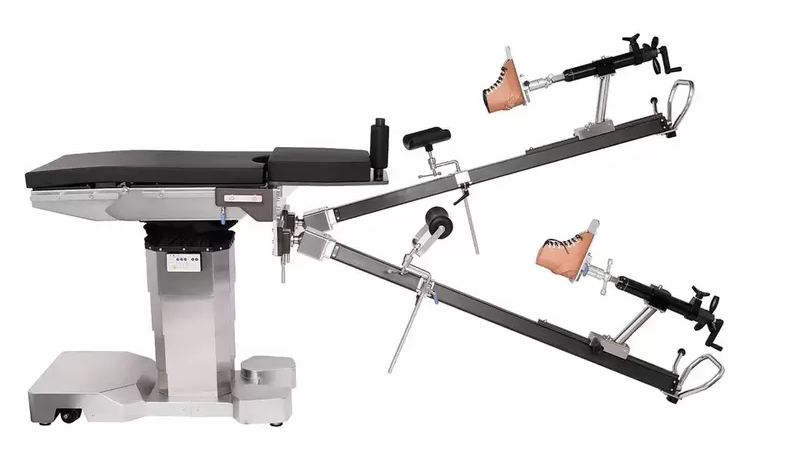

Introduction
Precision and stability are paramount in orthopedic and trauma surgery. One piece of equipment that has transformed the field is the surgical fracture table. Designed specifically for the management of lower limb fractures, this table provides unparalleled access, positioning, and stability, making complex procedures both safer and more efficient.
What Is a Surgical Fracture Table?
A surgical fracture table is a specialized operating table primarily used in orthopedic surgeries, especially those involving fractures of the femur, tibia, and hip. Unlike standard surgical tables, fracture tables are designed with mechanisms that enable precise traction and positioning of limbs, allowing surgeons to maintain alignment throughout the procedure.

Clinical Applications of Fracture Tables
Surgical fracture tables are indispensable for a range of orthopedic and trauma procedures. Common applications include:
1. Hip Fracture Fixation: Procedures like intramedullary nailing and dynamic hip screw (DHS) fixation rely heavily on precise reduction, which fracture tables facilitate through longitudinal traction and stable positioning.
2. Femoral Shaft Fractures: The traction system helps align fractured femoral segments while maintaining sterility and accessibility for the surgeon.
3. Tibial and Pelvic Surgeries: Fracture tables support both supine and lateral positions, making them adaptable for various lower extremity and pelvic fracture procedures.
4. Minimally Invasive Orthopedic Techniques: With excellent radiolucency and C-arm compatibility, fracture tables are ideal for minimally invasive procedures, ensuring less tissue damage and quicker recovery times.
Advantages of Using a Surgical Fracture Table
✅ Precise Patient Positioning: Proper alignment is critical in orthopedic surgery. Fracture tables provide reproducible positioning for consistent surgical outcomes.
✅ Traction Control: Integrated traction systems allow surgeons to apply controlled force to the fractured limb, aiding in reduction without manual assistance.
✅ Enhanced Imaging: The radiolucent surface enables real-time fluoroscopic guidance, crucial in fracture fixation procedures.
✅ Improved Surgical Access: With limbs secured and traction applied, the surgical field remains unobstructed, enabling better visualization and access.
✅ Increased Operating Room Efficiency: Fracture tables reduce the need for manual limb manipulation by assistants, streamlining procedures and reducing fatigue for the surgical team.
Key Considerations When Choosing a Fracture Table
When selecting a surgical fracture table for your operating room, consider the following:
- Traction adjustability: Look for fine-tuning mechanisms
- Weight capacity: Ensure stability for patients of all sizes
- Imaging compatibility: Full-length radiolucency is a must
- Modularity: Tables with interchangeable accessories offer more versatility
- Ease of use: Quick setup and intuitive controls save valuable OR time
Conclusion
A surgical fracture table is far more than a support surface—it is a vital orthopedic tool that enhances surgical accuracy, safety, and efficiency. With the growing demand for minimally invasive techniques and improved patient outcomes, investing in high-quality fracture tables is a forward-thinking move for any modern surgical facility.
Explore Our Surgical Fracture Tables
Medik offers advanced fracture tables engineered for precision, comfort, and durability. Explore our surgical fracture tables or contact us for more information on how our solutions can enhance your orthopedic surgical outcomes.
References
1. Bucholz, R.W., Court-Brown, C.M., Heckman, J.D., Tornetta, P. (2012). Rockwood and Green's Fractures in Adults. 7th Edition. Philadelphia: Lippincott Williams & Wilkins.
2. Ricci, W.M., Gallagher, B., Haidukewych, G. (2009). Intramedullary Nailing of Femoral Shaft Fractures: Current Concepts. Journal of the American Academy of Orthopaedic Surgeons, 17(5), 296–305. https://doi.org/10.5435/00124635-200905000-00004
3. Tornetta, P., Kain, M.S., Creevy, W.R. (2007). Reamed Intramedullary Nailing of Femoral Fractures: Effect of Fracture Type on Outcomes. Clinical Orthopaedics and Related Research, 454, 225–229. https://doi.org/10.1097/BLO.0b013e31802b4c09
4. Moed, B.R., Watson, J.T. (1995). The use of the fracture table for reduction and fixation of acetabular fractures. Journal of Orthopaedic Trauma, 9(2), 124–129. https://doi.org/10.1097/00005131-199504000-00006
5. Weber, B.G., Brunner, C., Freuler, F. (1980). Treatment of Fractures in the Osteoporotic Bone. Berlin: Springer-Verlag.
6. Zlowodzki, M., Bhandari, M., Marek, D.J., Cole, P.A., Kregor, P.J. (2006). Operative treatment of acute diaphyseal fractures of the femur: Comparison of intramedullary nailing and plate fixation. Journal of Orthopaedic Trauma, 20(7), 438–445.
7. AO Foundation. (2023). Fracture table setup for femoral fractures – AO Surgery Reference. https://surgeryreference.aofoundation.org